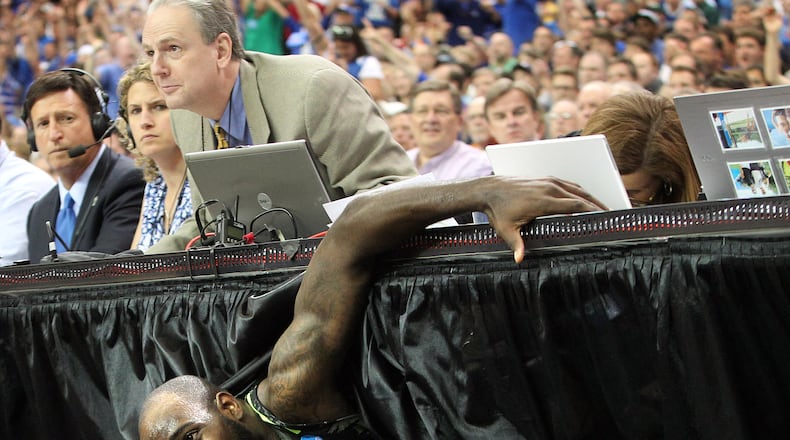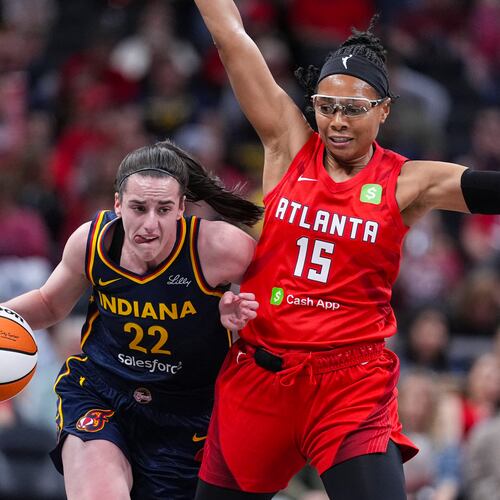The closest any UCLA team of the Abdul-Jabbar (nee Alcindor) era came to losing in an NCAA tournament came in the 1969 Final Four against Drake. The game was played in Louisville, Ky. I lived 2 1/2 hours from Freedom Hall, and I couldn’t watch it. The game wasn’t televised in the Eastern part of these United States.
In 2012, I saw very little of the NCAA tournament on television. But I watched a bunch of it on my iPad.
There was a time when the Big Dance wasn’t even the biggest college basketball tournament — as late as the 1950s, the NIT was seen as the one to win — but now these three weeks command the ongoing attention of the American public in a way no other continuing sporting event does. Think about it. When last did your office have a World Series pool?
The NCAA tournament, the 75th installment of which concludes at the Georgia Dome on Monday, is perfect for these multi-platform times. Everybody can fill out a bracket and enter somebody’s contest — here we humbly note that Bradley’s Bracket Fiasco is in its 26th year — and folks can watch whatever game they choose anywhere there’s WiFi. Who knew that the tournament that once didn’t see a need to offer both national semifinals to the nation would become a cutting-edge colossus?
Back in the day, college basketball was seen as a regional sport. The UCLA dynasty helped forge a national commonality, and the end of UCLA’s reign left replaced order with glorious chaos. The NCAA tournament started to get really good in the late ’70s, and the ’80s offered a run of so many thrills — Jordan sinking Georgetown; Phi Slama Jama undone by a jam; Villanova making everything it threw at the hoop — that it seemed scripted by a hoops-centric deity.
And television, which once didn’t know what to make of this curious tournament, reaped the whirlwind. On one Saturday in March 1981, NBC used its whip-around strategy to beam three buzzer-beating finishes — Saint Joseph’s stunning DePaul; U.S. Reed from half court; Rolando Blackman from the baseline — that proved it was possible to show pretty much everything to pretty much everybody. (That was NBC’s last year of televising the NCAA, but what an exit.)
The other part that changed about the NCAA tournament was the part that we now take for granted — the upsets. There weren’t very many of those in the tournament’s first 36 years for a simple reason: Not many teams were invited. Only in 1975, when the one-team-per-conference rule was ditched, did March Madness begin to go well and truly mad. Within a decade, we would see the fourth-place team from the ACC stand on a stage in an Albuquerque, N.M., arena known as The Pit and receive the plaque that goes only to national champions.
The tournament got bigger, wilder, better. We began to watch not just to see the Brand Names, but to see if some directional school — Middle Tennessee, say, or Northern Iowa — could take down a member of the sport’s royal family. We completed our brackets and saw them shredded by reality, and somehow none of us complained. (Except Georgetown fans. They still haven’t gotten over Villanova and its 78.6 percent. Indeed, they insist the epic game never happened.)
Then the little guys got big themselves. George Mason went to the Final Four. Virginia Commonwealth went from the First Four in the Dayton play-in round to the Final Four in Houston. Butler graced consecutive NCAA finals and came within Gordon Hayward’s 45-foot near-miss of being crowned champion. The NCAA tournament could no longer be confused with the NBA playoffs, where chalk tends to prevail. The NCAA tournament became the realm where no chalk existed.
That’s why, even at a time when interest in college basketball’s regular season has receded; even when the raft of one-and-dones has devalued the sport and all who sail in it; even in a year when nobody could score … even now, the Big Dance stands tall. We might not know who these guys are, and we might know full well that the best of them will be gone to the NBA before you can say “Ali Farokhmanesh” — yep, another Northern Iowa reference — but for three weeks we don’t care.
Every NCAA tournament might not produce a great champion (although the 2012 installment did), but every NCAA tournament will stir the senses. We’ll see the upsets and the close shaves, some excellence and some ineptitude, a no-few no-names rising and a few big boys crashing. We’ll see an event that’s never quite the same, but that always tugs the same heartstrings. And then we’ll arrive, not a moment too soon, at the Final Four.
It was CBS, which took over for NBC in 1982, that coined the phrase, “The Road to the Final Four,” and in all of American sports there are no six words more evocative. The NBA finals and the World Series and even the almighty Super Bowl don’t offer the same sense of shared destination; those events have room for only two. Here beneath the off-white Georgia Dome roof we have four teams, four coaches, four compelling stories.
Sixty-eight teams began this journey, and 64 have been waylaid. Some have already been forgotten, and some we’ll long remember, and now we focus on the four who remain. The NCAA tournament once was the province of giants, but now the little guys know they have a chance to leave their imprint, and we’ll all, to borrow from Nike regarding LeBron James, be witnesses.
Back to 1969, to UCLA-Drake. In an era of few real NCAA upsets, that would have been the all-timer forever and ever. A team from Des Moines, Iowa, and the Missouri Valley Conference toppling the greatest player and the greatest coach the sport had ever known? Get outta town.
It almost happened. The Bulldogs’ Dolph Pulliam made a follow to cut UCLA’s lead to 83-82 in the dying seconds, but the left-handed Bruin Lynn Shackelford was fouled just before the final horn and made two free throws. And to this day, I have never seen a clip — not a one, not even on YouTube — from that game.
But that was when the Dance wasn’t so big, when the tournament included 25 teams and the East stayed East and the West stayed West, when the championship game was played on Saturday afternoon. And back then the Final Four wasn’t even called the Final Four. Just the national semifinals.
Now the whole thing is so immense you need three TVs (or one iPad) to follow it. Now the strangely designed little tournament — why were there seven teams in the East Regional in 1969 but only six in the other three? — has become a massive part of American life. Every March it begins again, and every April we stay tuned until the final strains of “One Shining Moment” have faded, and every time we behold something wondrous. Every blessed time.
About the Author
Keep Reading
The Latest
Featured



